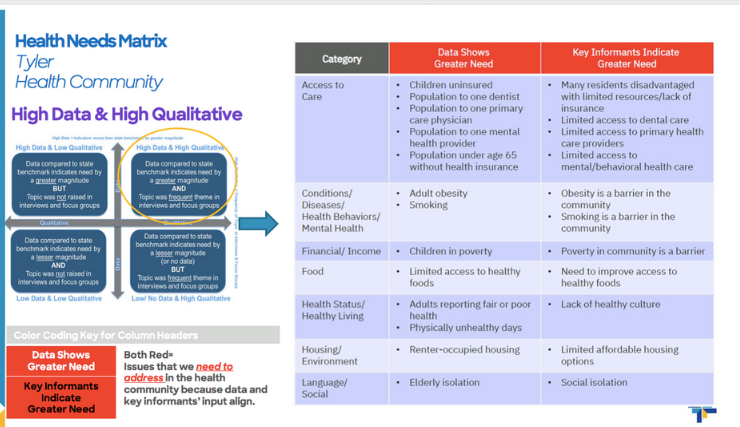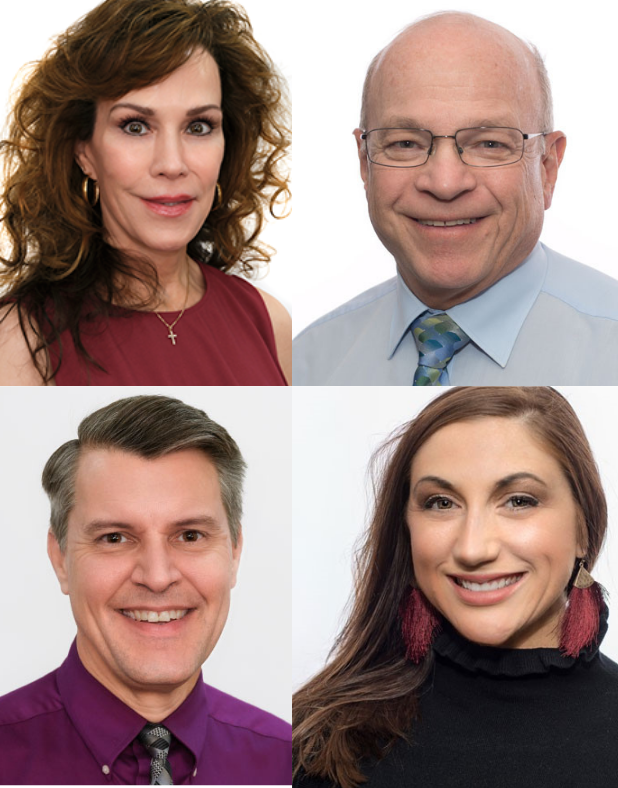What circumstance is shared by people in East Texas and China? Although it sounds like the set up for a banal joke, the question has at least one answer pointing to a real throughline.
Dr. Matt Humphries, MD, maintains a family practice at Bethesda Clinic in Tyler. He previously worked in Macau, China, for 18 years.
“A lot of it was similar in that people there were not insured. And for some people, resources were pretty limited,” he said.
Although awash in medical systems, barriers to health and health access for East Texans remain, including insurance.
Since 2003, Bethesda Health Clinic is East Texas’ only nonprofit health clinic created to serve uninsured adults with affordable healthcare through 100% community supported funds.
Amid robust hospitals and clinics, how is Bethesda Health Clinic performing triage in the uninsured gap?
Before that question is unpacked, a study of extremes in East Texas healthcare is helpful.
A study in extremes
Three colossal healthcare systems – UT Health, Christus Trinity Mother Frances and Baylor, Scott and White – serve East Texas. Their presence leaves an indelible print on East Texas’ employment, economy and housing. Tyler’s healthcare industry boasts the largest segment of the city’s economy by number of people employed, an impact projected to increase with UT Health’s medical school beginning the summer of 2023.

Meanwhile, East Texans’ physical and mental health rates poorly. In 2016, UT Health Northeast reported higher rates of mortality among Northeast Texans for each of the five leading causes of death in the U.S. — heart disease, cancer, stroke, chronic lower respiratory diseases and unintentional injury.
Moreover, East Texas infant mortality and prevalence of diabetes rank more dismally than the rest of Texas.
As for mental health, “Northeast Texas has a suicide rate 43% higher than the state average,” said Brittney Nichols, director for the Department of Psychiatry and Behavioral Medicine at UT Health Science Center.
Insurance: A critical piece in outcomes

A community health needs assessment by Baylor, Scott and White analyzed public health data for Anderson, Gregg, Smith and Wood counties over the 2020 fiscal year. The four counties make up more than 80% of hospital admissions in East Texas. The assessment determined 20% of the population surveyed were uninsured.
Medical workers new to East Texas may be surprised and dismayed by the number of uninsured patients and their outcomes.

The Tyler Loop met with four Bethesda Clinic stakeholders – chief executive officer John English, MD; nurse practitioner Karin Grantham; Megan Riaz, director of community relations; and Humphries – to hear more.
All-too-common chronic illness scenarios
English said most of the clinic’s patients are in their 40s and 50s, and most have a chronic illness like high blood pressure, diabetes, depression or anxiety, heart issues and asthma or emphysema.
He explained how an untreated health issue like Type 2 diabetes can have multiple negative impacts.
“If you don’t treat it, one of two things happens … they’re going to either have a major heart event or they’re going to start having a lot of complications that put them on disability, unable to take care of their family,” English said
“And those can go on for years. There’s a financial drain to the family, to the society, the community, everybody else. If they go to the hospital, their hospital stay will be two to three times as long and cost two to three times as much.”
Who qualifies for Bethesda and why are they uninsured?
People who can receive healthcare from Bethesda may not realize they qualify.
“We know being uninsured in the medical realm gets very expensive very quickly. So even if you’re making some income, it’s just very difficult to have enough to be able to cover all that,” English said.

Riaz explained the criteria to qualify for care. “Anyone who earns within 300% of the federal poverty level will qualify,” she said. For example, a family of four whose total earnings per year are $78,600 would qualify at Bethesda.
For those who qualify, Bethesda charges $20 or $30 for an initial visit fee based on a patient’s income.
Some uninsured patients work part-time jobs or full-time jobs in the service industry that don’t offer insurance.
“Some of the companies offer it, but they’re very expensive. [Patients are] spending hundreds of dollars per month, and they’re not making all that much money,” English said. “Some of them are healthy at the time, and they don’t necessarily need it. So they’ll just take a chance.
“That’s probably one of the biggest challenges our patients have: trying to make long-term decisions, when there’s so many short-term problems going on,” he said.
Grantham, who began volunteering at Bethesda in 2016, now serves as a staff member as nurse practitioner. Her choice to work at Bethesda became clear through prayer.
“I asked God to put me where I could do the most, and I feel like he did,” Grantham said.
Like English, Grantham is familiar with the plight of many of the clinic’s patients.
“The health of our neighbors is really poor. When I saw that, it motivated me to reactivate my nursing license…I expanded my licensure to become a nurse practitioner,” she said.
Grantham encourages patients to take responsibility for what they can do to be healthy.
“I think people don’t realize the power they have to influence their own health. I tell my patients that the most power they have is over what they put in their mouth,” she said.
“A lot of people think about what is restricted. I try to introduce people to all the things you can eat, and these are healthy and they make you feel good on a day-to-day basis,” Grantham said.
Outside of Bethesda, which options exist for the uninsured?
When asked what would happen to East Texans without insurance if Bethesda were not there, Grantham painted a bleak picture.
“I think many of them would inappropriately use the emergency room to take care of just the normal day to day,” she said.
“A lot of them might either go undiagnosed until whatever disease has wreaked havoc on long-term health. Even if they’re diagnosed, it might go untreated to where they suffer the long-term effects of not controlling your diabetes or high blood pressure or cholesterol.”
Grantham said sometimes patients who come to the clinic for one reason are often surprised to find they have multiple underlying conditions needing attention.
When needs arise – from mental health to employment to dental work – Bethesda responds. Grantham praised her colleagues’ resourcefulness.
“We have great, kind, generous volunteers. Our staff here stuns me all the time because when we don’t easily have access to things, they help find it,” she said.

Grantham said Bethesda staff and volunteers help explore insurance at lower rates for patients. They also work with local services such as the Texas Workforce Commission to find consultations and surgery.
Like English and Grantham, Humpries said many of Bethesda’s patients suffer from diabetes and hypertension. He also gave an example of patients with mental health issues.
“We do see a lot of mental health patients. A lot of people work long hours. Like yesterday, there were a couple of patients feeling down and depressed or anxious where they’re working 70 hours a week, and it’s been worse this year because it’s been harder for some of their employees to find workers. That puts more strain and stress on them,” Humpries said.
Bethesda patients receive screenings for depression and anxiety within their second visit to the clinic, Humphries said.
What can a Bethesda patient expect?
For uninsured patients who are likely to use the emergency room when a health crisis arises, Humphries wishes they could know about Bethesda.
“I wish they would have known that we were here, we’re available and we do a good job here. We will listen to them and we’ll care for them,” Humphries said.

“We try to get medications at an affordable price for them. And we do have some samples that can supplement medications. We try to be holistic in the way we meet their needs – meet their physical needs but also listen to their emotional needs.”
While their healthcare workers stay busy, Humphries said patients may experience a difference in the pace and care at Bethesda.
“Our goal is just not to get them in and out. Sometimes, we’re able to spend a bit more time with them. We’re busy, but there’s not a great pressure for more and more volume. We have good availability,” he said.
“Usually we can see them within a day or two – sometimes on the same day. It’s not going to be a long time before they can see the doctor. We do all we can to help them and to get their medical conditions under control,” Humphries said.
Grantham and English talked about what motivates their work.
“We want to take care of them so they can live the best life possible. Our vision is that patients will live the John 10:10 life: to live life to the fullest.
“There’s just nothing better than seeing people get better,” Grantham said.
Love what you're seeing in our posts? Help power our local, nonprofit journalism platform — from in-depth reads, to freelance training, to COVID Stories videos, to intimate portraits of East Texans through storytelling.
Our readers have told us they want to better understand this place we all call home, from Tyler's north-south divide to our city's changing demographics. What systemic issues need attention? What are are greatest concerns and hopes? What matters most to Tylerites and East Texans?
Help us create more informed, more connected, more engaged Tyler. Help us continue providing no paywall, free access posts. Become a member today. Your $15/month contribution drives our work.







